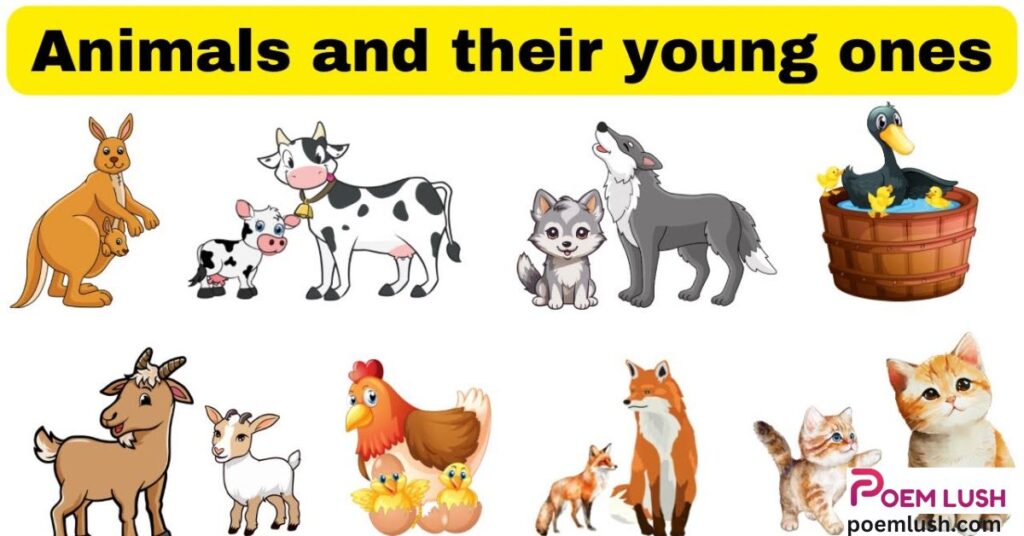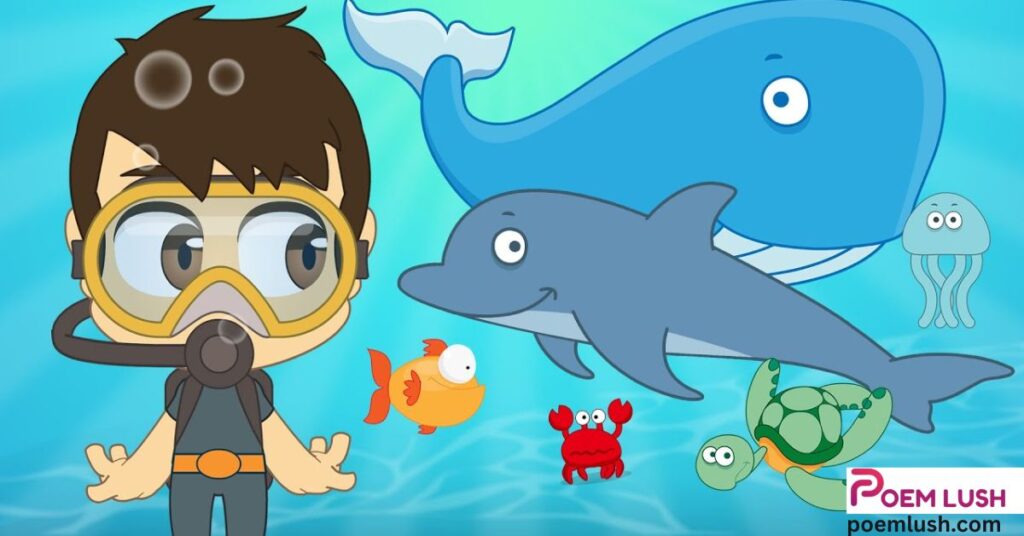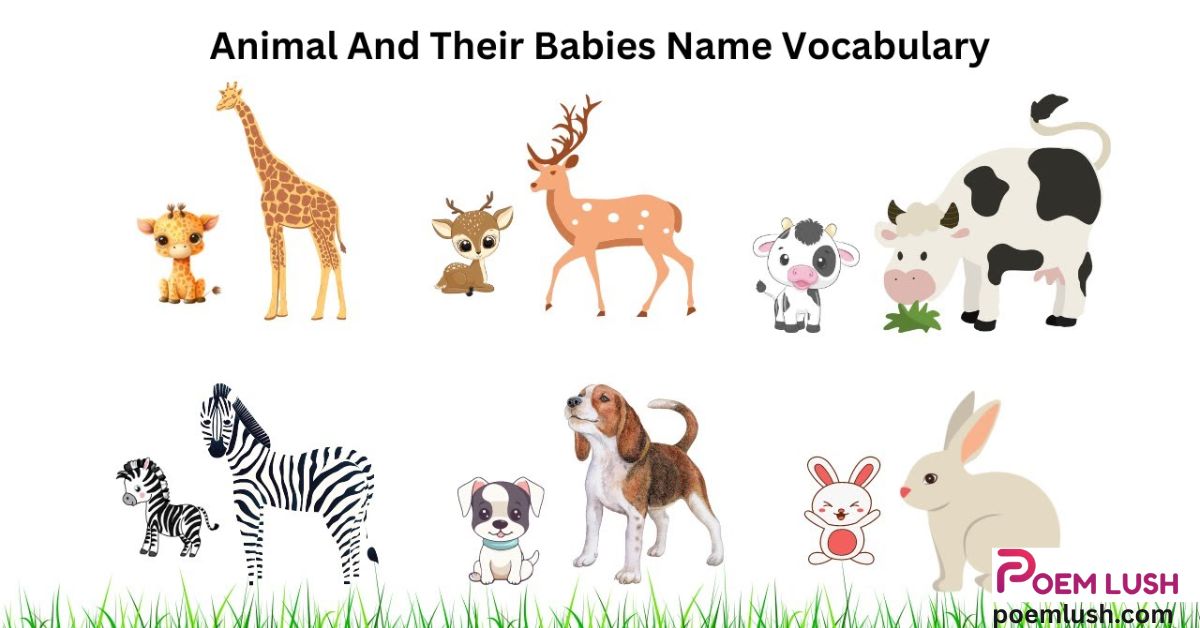Understanding the names of animals and their young is both fascinating and educational. This comprehensive guide covers 100 animals and their babies names in English with pictures, providing insights into various species across the animal kingdom. 100 Animals and Their Babies Names in English with Pictures
Mammals and Their Young

Mammals are warm-blooded animals that usually give birth to live young and nourish them with milk. Here are some examples of popular mammals and the names of their babies: 100 Animals and Their Babies Names in English with Pictures
Dogs have babies called puppies, which are born blind and deaf but quickly develop senses in the first few weeks.
Cats give birth to kittens, small and curious babies that begin exploring their surroundings within a few days.
Cows have calves, and these newborns can stand and walk within an hour of birth, a survival adaptation.
Horses also produce foals, strong-legged babies who can gallop within a few hours.
Sheep have lambs, known for their soft bleating and close bonding with their mothers.
Goats produce kids, agile and playful from a very young age.
Pigs give birth to piglets, which are social animals often seen suckling together.
Elephants have calves, massive babies weighing over 200 pounds at birth who stay close to their mothers for years.
Lions and tigers give birth to cubs, adorable and fiercely protected by their mothers.
Bears produce cubs that stay with their mother for up to two years, learning survival skills.
Deer give birth to fawns, known for their spotted coats that help camouflage them in the wild.
Wolves have pups, which are raised by the entire pack.
Foxes also produce kits or pups, which are cared for in underground dens.
Kangaroos birth tiny joeys that develop in their mother’s pouch.
Bats give birth to pups that cling to their mothers or roosts.
Whales and dolphins have calves that nurse from their mothers and stick closely by their sides for safety.
Rabbits give birth to kits or bunnies, typically hidden in shallow nests.
Hedgehogs have babies called hoglets, which are born with soft spines.
Moose give birth to calves that grow rapidly during summer months.
Birds and Their Chicks
Birds lay eggs, and when those eggs hatch, out come chicks. These chicks vary in color, size, and behavior across species.
Chickens give birth to chicks, which peep and peck instinctively soon after hatching.
Ducks produce ducklings who can swim almost immediately.
Geese have goslings, and these fluffy babies often follow their parents in long lines.
Swans produce cygnets, elegant young birds covered in gray down.
Owls give birth to owlets, who depend on their parents for food during their early life.
Eagles raise eaglets, which grow rapidly due to a protein-rich diet.
Penguins nurture their chicks in icy climates, balancing them on their feet for warmth.
Parrots, flamingos, and peacocks also produce chicks with unique traits.
Robins, sparrows, and crows care attentively for their chicks in nests.
Woodpeckers raise their young in tree holes, protecting their chicks from predators.
Reptiles and Amphibians
Reptiles and amphibians don’t all raise their young, but they still have distinct baby names and reproductive methods.
Snakes produce snakelets, often hatched fully formed from eggs or born live.
Lizards also have hatchlings, which emerge independently and start fending for themselves right away.
Crocodiles produce hatchlings too. Uniquely, mothers guard their nests and may even carry babies to the water in their mouths.
Turtles lay eggs that hatch into hatchlings who must instinctively rush to the sea.
Frogs begin life as tadpoles, swimming and breathing with gills before transforming into adult frogs.
Salamanders may be born in water or on land, with the juvenile form called an eft in newts.
Geckos, chameleons, and iguanas also hatch as independent hatchlings with strong instincts.
Toads develop similarly to frogs, starting as tadpoles.
Alligators guard their nests and help their hatchlings get to the water after hatching.
Aquatic Animals

In aquatic life, baby names vary, but their beginnings are just as fascinating.
Fish give birth to or lay eggs that hatch into fry, small fish who often stay in groups for safety.
Sharks produce pups, and depending on the species, these pups may hatch inside the mother or be born alive.
Dolphins have calves that stay with their mothers for years, learning to navigate and hunt.
Whales also raise calves, and these young giants feed on rich milk to grow quickly.
Octopuses begin life as larvae, drifting in the ocean currents before maturing.
Jellyfish start out as ephyra, tiny star-shaped juveniles that grow into the iconic bell shape.
Seahorses give birth to fry, and interestingly, it’s the males who carry the pregnancy.
Clownfish lay eggs that hatch into tiny fry who find shelter in anemones.
Crabs begin life as zoea, floating larvae that eventually settle on the ocean floor.
Lobsters and shrimp start as larvae, developing complex features through molting.
Insects and Their Larvae
Insects often undergo complete metamorphosis, and their baby stages have very different names.
Butterflies start as caterpillars, which eat nonstop to prepare for transformation.
Bees and ants produce larvae, which are fed and protected in complex colonies.
Beetles hatch as grubs, wormlike creatures that tunnel and eat until they pupate.
Mosquitoes develop as larvae in water, where they’re known as wrigglers.
Flies produce maggots, vital decomposers in ecosystems.
Moths begin life as caterpillars similar to butterflies, with some growing quite large.
Grasshoppers hatch as nymphs, which resemble adults but lack wings.
Dragonflies start as naiads, aquatic larvae that emerge and shed their skins.
Termites also go through larval stages cared for by worker castes.
Crickets develop as nymphs, growing in stages and eventually gaining wings.
Fun Facts and Trivia

- Did you know? A baby hare is called a leveret, and it’s born with fur and open eyes.
- Kangaroo babies are called joeys and spend months developing inside their mother’s pouch.
- A baby platypus is often called a puggle, a rare example of mammals that lay eggs.
- Pandas have the smallest babies relative to their adult size — about the size of a stick of butter.
- Hippo calves are born underwater and must surface to take their first breath.
- A giraffe calf can stand within 30 minutes and run within 10 hours after birth.
- Baby armadillos are called pups and are born with soft shells that harden over time.
Conclusion
Exploring 100 animals and their babies names in English with pictures offers far more than just fun trivia—it opens a window into the wonders of life, language, and learning. Each baby animal’s name tells a story, whether it’s a kitten curling beside its mother or a duckling paddling after its parent on a quiet lake.
For young learners, this list is a brilliant way to build vocabulary and spark curiosity about the natural world. Pictures bring words to life, helping children remember and relate to each animal with ease. For ESL students, it bridges the gap between language and context, making English vocabulary more memorable and meaningful.
FAQs
What is the baby of a kangaroo called?
The baby kangaroo is called a joey. Joeys are tiny when born and continue developing inside their mother’s pouch for several months.
Why do some animals have unique names for their babies?
Unique baby names often come from historical, cultural, or biological factors. For example, calves for cows and elephants reflect early English origins, while terms like puggle for a baby platypus highlight the animal’s unique traits.
Are all baby animal names different from their parents’ names?
Not always. Some animals share the same name for both adults and babies, like fish or snakes, while others have specific names such as puppy for a dog’s baby or cygnet for a baby swan.
How can pictures help in learning animal baby names?
Pictures make it easier to associate names with real animals, helping memory retention and making learning more engaging, especially for children and visual learners.
Where can I find more information and pictures about animals and their babies?
Educational websites like National Geographic Kids, animal encyclopedias, and wildlife conservation sites offer extensive galleries and facts about animals and their babies, providing accurate and fun learning resources.


